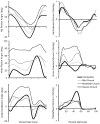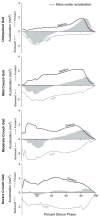Muscle contributions to vertical and fore-aft accelerations are altered in subjects with crouch gait
- PMID: 23200083
- PMCID: PMC3600387
- DOI: 10.1016/j.gaitpost.2012.10.019
Muscle contributions to vertical and fore-aft accelerations are altered in subjects with crouch gait
Abstract
The goals of this study were to determine if the muscle contributions to vertical and fore-aft acceleration of the mass center differ between crouch gait and unimpaired gait and if these muscle contributions change with crouch severity. Examining muscle contributions to mass center acceleration provides insight into the roles of individual muscles during gait and can provide guidance for treatment planning. We calculated vertical and fore-aft accelerations using musculoskeletal simulations of typically developing children and children with cerebral palsy and crouch gait. Analysis of these simulations revealed that during unimpaired gait the quadriceps produce large upward and backward accelerations during early stance, whereas the ankle plantarflexors produce large upward and forward accelerations later in stance. In contrast, during crouch gait, the quadriceps and ankle plantarflexors produce large, opposing fore-aft accelerations throughout stance. The quadriceps force required to accelerate the mass center upward was significantly larger in crouch gait than in unimpaired gait and increased with crouch severity. The gluteus medius accelerated the mass center upward during midstance in unimpaired gait; however, during crouch gait the upward acceleration produced by the gluteus medius was significantly reduced. During unimpaired gait the quadriceps and ankle plantarflexors accelerate the mass center at different times, efficiently modulating fore-aft accelerations. However, during crouch gait, the quadriceps and ankle plantarflexors produce fore-aft accelerations at the same time and the opposing fore-aft accelerations generated by these muscles contribute to the inefficiency of crouch gait.
Copyright © 2012 Elsevier B.V. All rights reserved.
Conflict of interest statement
None of the authors had financial or personal conflict of interest with regard to this study. Original Article
Figures




Similar articles
-
Muscle contributions to support and progression during single-limb stance in crouch gait.J Biomech. 2010 Aug 10;43(11):2099-105. doi: 10.1016/j.jbiomech.2010.04.003. Epub 2010 May 20. J Biomech. 2010. PMID: 20493489 Free PMC article.
-
How much muscle strength is required to walk in a crouch gait?J Biomech. 2012 Oct 11;45(15):2564-9. doi: 10.1016/j.jbiomech.2012.07.028. Epub 2012 Sep 5. J Biomech. 2012. PMID: 22959837 Free PMC article.
-
Muscular contributions to hip and knee extension during the single limb stance phase of normal gait: a framework for investigating the causes of crouch gait.J Biomech. 2005 Nov;38(11):2181-9. doi: 10.1016/j.jbiomech.2004.09.036. Epub 2004 Nov 23. J Biomech. 2005. PMID: 16154404
-
Muscle and joint function in human locomotion.Annu Rev Biomed Eng. 2010 Aug 15;12:401-33. doi: 10.1146/annurev-bioeng-070909-105259. Annu Rev Biomed Eng. 2010. PMID: 20617942 Review.
-
Crouch gait or flexed-knee gait in cerebral palsy: Is there a difference? A systematic review.Gait Posture. 2020 Oct;82:153-160. doi: 10.1016/j.gaitpost.2020.09.001. Epub 2020 Sep 6. Gait Posture. 2020. PMID: 32927222
Cited by
-
The functional roles of muscles during sloped walking.J Biomech. 2016 Oct 3;49(14):3244-3251. doi: 10.1016/j.jbiomech.2016.08.004. Epub 2016 Aug 6. J Biomech. 2016. PMID: 27553849 Free PMC article.
-
A rolling constraint reproduces ground reaction forces and moments in dynamic simulations of walking, running, and crouch gait.J Biomech. 2013 Jun 21;46(10):1772-6. doi: 10.1016/j.jbiomech.2013.03.030. Epub 2013 May 21. J Biomech. 2013. PMID: 23702045 Free PMC article.
-
The coupled effects of crouch gait and patella alta on tibiofemoral and patellofemoral cartilage loading in children.Gait Posture. 2018 Feb;60:181-187. doi: 10.1016/j.gaitpost.2017.12.005. Epub 2017 Dec 5. Gait Posture. 2018. PMID: 29248848 Free PMC article.
-
Soft tissue can absorb surprising amounts of energy during knee exoskeleton use.J R Soc Interface. 2024 Dec;21(221):20240539. doi: 10.1098/rsif.2024.0539. Epub 2024 Dec 4. J R Soc Interface. 2024. PMID: 39626746 Free PMC article.
-
Modelling the interaction between wearable assistive devices and digital human models-A systematic review.Front Bioeng Biotechnol. 2023 Jan 10;10:1044275. doi: 10.3389/fbioe.2022.1044275. eCollection 2022. Front Bioeng Biotechnol. 2023. PMID: 36704313 Free PMC article.
References
-
- Wren TA, Rethlefsen S, Kay RM. Prevalence of specific gait abnormalities in children with cerebral palsy: influence of cerebral palsy subtype, age, and previous surgery. J Pediatr Orthop. 2005;25:79–83. - PubMed
-
- Jahnsen R, Villien L, Aamodt G, Stanghelle JK, Holm I. Musculoskeletal pain in adults with cerebral palsy compared with the general population. J Rehabil Med. 2004;36:78–84. - PubMed
-
- Graham H, Selber P. Musculoskeletal aspects of cerebral palsy. J Bone Joint Surg Br. 2003;85:157–66. - PubMed
-
- Rose J, Gamble JG, Medeiros J, Burgos A, Haskell WL. Energy cost of walking in normal children and in those with cerebral palsy: comparison of heart rate and oxygen uptake. J Pediatr Orthop. 1989;9:276–9. - PubMed
-
- Waters RL, Mulroy S. The energy expenditure of normal and pathologic gait. Gait Posture. 1999;9:207–31. - PubMed
Publication types
MeSH terms
Grants and funding
LinkOut - more resources
Full Text Sources
Other Literature Sources
Medical

